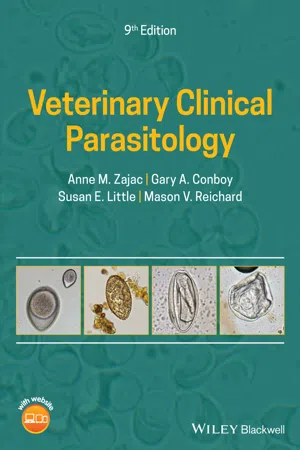
Veterinary Clinical Parasitology
- English
- ePUB (mobile friendly)
- Available on iOS & Android
Veterinary Clinical Parasitology
About this book
Veterinary Clinical Parasitology, 9th Edition, allows for a quick and accurate reference to internal and external parasites found in a wide variety of domestic animals and laboratory animal host species. Focusing on the tests and information most relevant to daily veterinary practice, this classic benchtop manual contains a wealth of high-quality images to assist readers in diagnosing parasitic disease and identifying and treating relevant parasites. Contributions by leading experts in veterinary pathobiology and parasitology cover fecal examination for the diagnosis of parasitism, detection of parasites in the blood, diagnosis of arthropod parasites, and more.
The latest edition contains fully revised material throughout, including new and expanded information on immunodiagnostic and molecular diagnostic tests, additional parasite-specific material on the benefits and limitations of different test modalities, and increased coverage of reptiles, birds, and other exotic and laboratory animals. New sections include up-to-date information on anthelmintics, antiprotozoals, and other antiparasitic drugs, and challenging case studies that provide insights on situations where identification of parasites is especially difficult. Published under the auspices of the American Association of Veterinary Parasitologists (AAVP), this indispensable clinical manual:
- Describes accurate and cost-effective techniques for diagnosiing parasitic infections in animals
- Presents clear and concise information on the distribution, life cycle, and significance of each parasite covered
- Contains hundreds of color clinical images to enable rapid picture-matching and aid in diagnosis
- Offers a spiral-bound format that allows the book to lie flat on the benchtop, ideal for regular use in daily practice
- Features revised content throughout, including new chapters and images, an improved format, an enhanced color scheme, and an updated companion website
Veterinary Clinical Parasitology, 9th Edition is an essential resource for practicing veterinarians, veterinary technicians, diagnosticians, researchers, and students in need of a timely and efficient reference on morphologic identification of parasites in different animal species.
Frequently asked questions
- Essential is ideal for learners and professionals who enjoy exploring a wide range of subjects. Access the Essential Library with 800,000+ trusted titles and best-sellers across business, personal growth, and the humanities. Includes unlimited reading time and Standard Read Aloud voice.
- Complete: Perfect for advanced learners and researchers needing full, unrestricted access. Unlock 1.4M+ books across hundreds of subjects, including academic and specialized titles. The Complete Plan also includes advanced features like Premium Read Aloud and Research Assistant.
Please note we cannot support devices running on iOS 13 and Android 7 or earlier. Learn more about using the app.
Information
CHAPTER 1
Fecal Examination for the Diagnosis of Parasitism
COLLECTION OF FECAL SAMPLES
Table of contents
- Cover
- Table of Contents
- Title Page
- Copyright Page
- Preface
- Acknowledgments
- Authors
- About the Companion Website
- CHAPTER 1: Fecal Examination for the Diagnosis of Parasitism
- CHAPTER 2: Detection of Protozoan and Helminth Parasites in the Urinary, Reproductive, and Integumentary Systems and in the Eye
- CHAPTER 3: Detection of Parasites in the Blood
- CHAPTER 4: Immunodiagnostic and Molecular Diagnostic Tests in Veterinary Parasitology
- CHAPTER 5: Diagnosis of Arthropod Parasites
- CHAPTER 6: Parasites of Fish
- CHAPTER 7: Treatment of Veterinary Parasites
- CHAPTER 8: Diagnostic Dilemmas
- Bibliography
- Index
- End User License Agreement